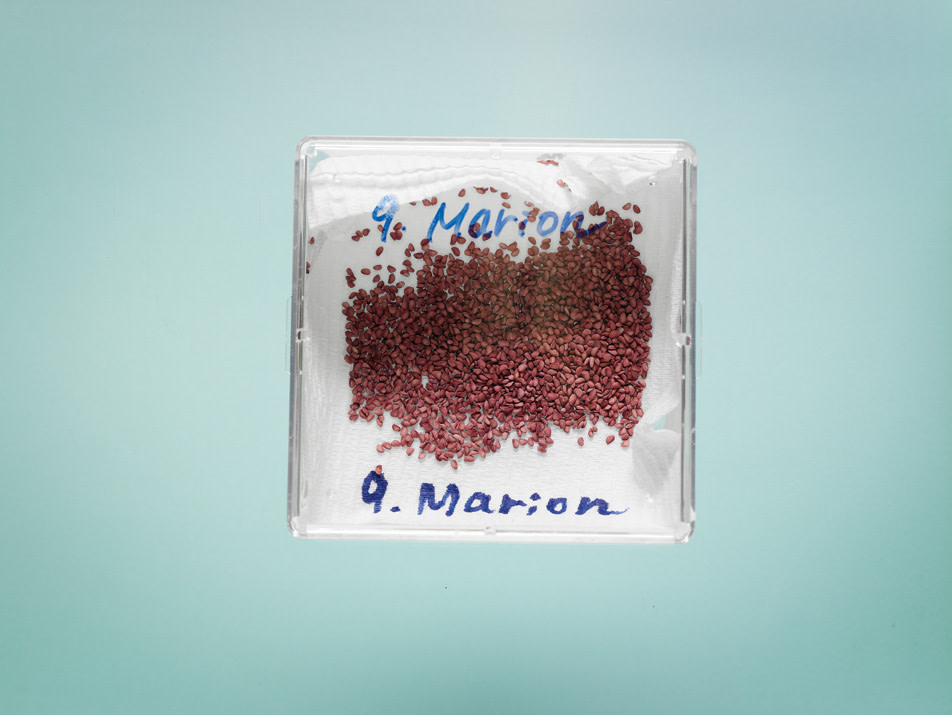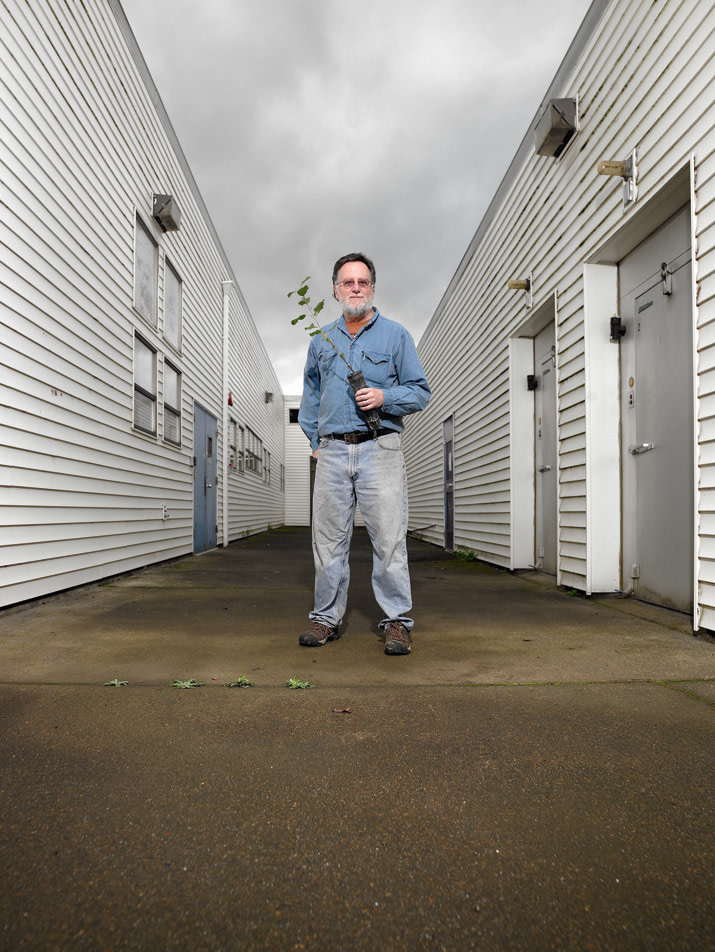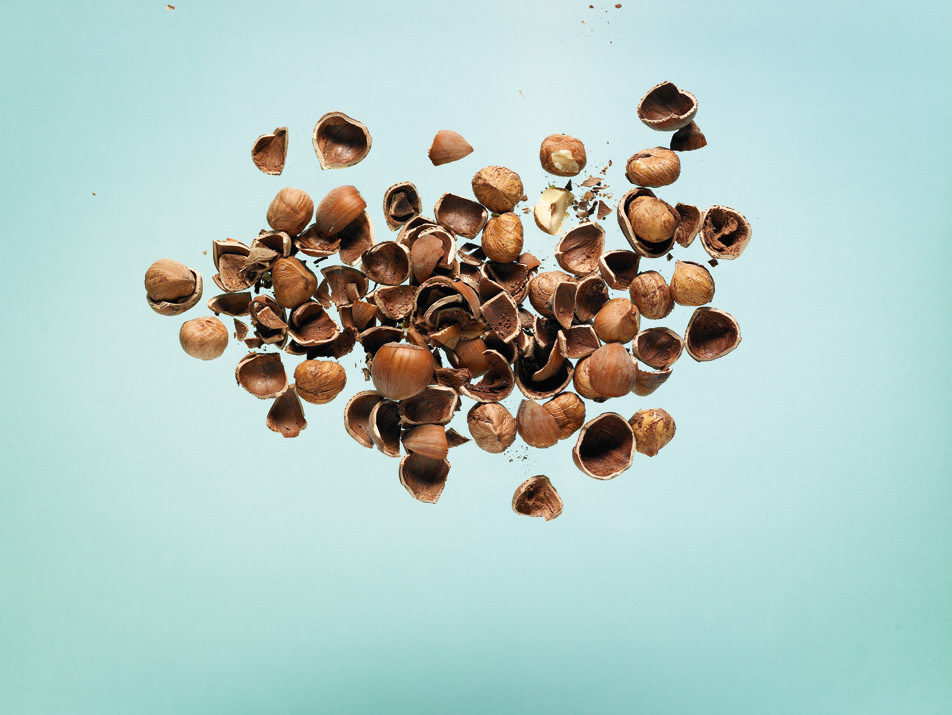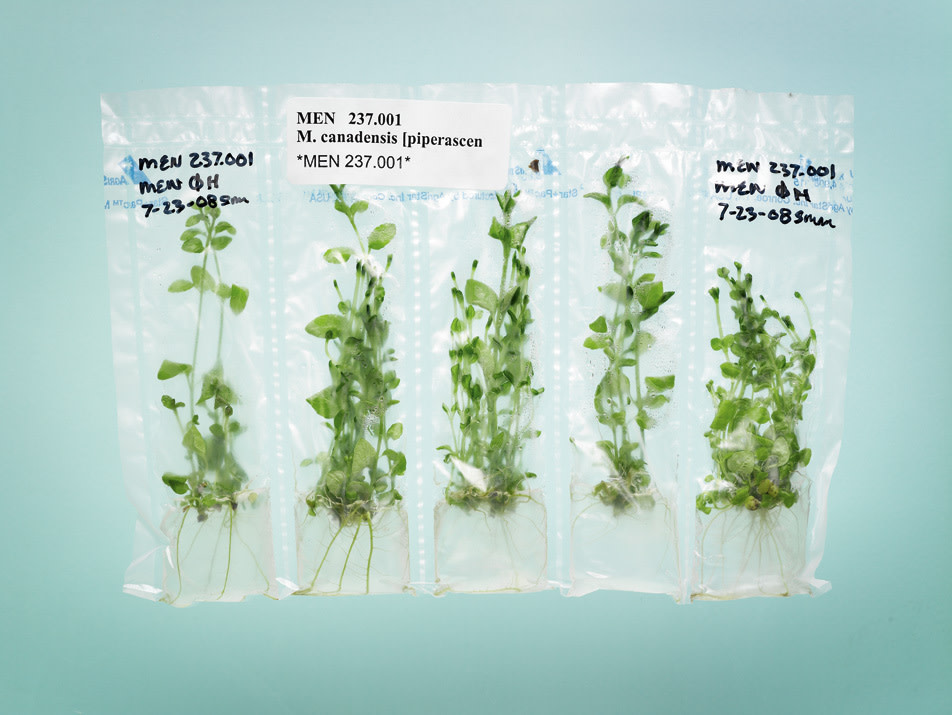Seed Saviors
HERE, in a building guarded only by a standard burglar alarm and a handful of exterior security cameras, scientists at the National Clonal Germplasm Repository, a unit within the United States Department of Agriculture’s Agricultural Research Service (USDA/ARS), are even now hedging against humanity’s uncertain future. Within the twenty-eight-year-old facility’s greenhouses, sheds, and freezers, which sprawl through sixty acres of orchards and field plantings, are the fruits and nuts and seeds and pollen of roughly ten thousand plants collected from all over the world. It is the repository’s job not only to protect these precious bits of propagation as some sort of worst-case-scenario refuge, but in many cases, to perfect them through countless rounds of experimentation, making their edible blooms and pomes a leafy Steve Austin: better, stronger, faster.
The plants under the care of the repository’s four USDA scientists and their ten-person support staff are the equivalent of rare artifacts in a museum, each containing a particular story of origin. Except that in this case, the museum pieces are alive. Inside one of a dozen screened sheds are the strawberries that were depicted in early fifteenth-century paintings of the Virgin Mary. Outside, in the orchard—where long rows of trees and shrubs trade shades of red, yellow, and pea green—are several varieties of pears that may have been eaten by the caesars of ancient Rome. There is medlar, a hard-skinned fruit with a mushy middle that Shakespeare used as a metaphor for women: half rotten, half ripe. There are golden quinces from Iran, heavy with a sweet aroma; historians think they, not the legendary apple, were the true stars of the Garden of Eden. There is hardy kiwi, native to the mountains of northeastern China, scaling a trellis—the fruit tastes like its fuzzy cousin but has a shiny, smooth surface.
Inside one of these greenhouses, diffused winter light streams through the glass ceiling, illuminating horticulturalist Kim Hummer and her colleagues as they hover over a small potted strawberry plant that, considering its history-steeped neighbors, appears undeserving of so much attention. Devoid of fruit, the plant’s heart-shaped leaves are edged brown, its runner pale red. It doesn’t look much different than any one of the other hundreds of strawberry plants crowding dozens of long tables. Yet Hummer’s voice brims with excitement. "This is a wild decaploid," she says. "It’s very special."
A Russian colleague of Hummer’s collected this wild strawberry, Fragaria iturupensis, from the side of a volcano on Russia’s Iturup Island. It has ten sets of chromosomes, more than any other known variety of wild strawberry. In general, plants with higher ploidy—the number of sets of chromosomes per cell—tend to have larger fruit. Hummer doesn’t yet know the possible value of such a plant, but she’s captivated by what it might reveal about the strawberry’s ancestry.
Tall, fair, and strawberry blond (yes, really), Hummer wears a vest printed with strawberries (yes, really), which, she matter-of-factly notes, are of another species, Fragaria vesca. In this land of horticulture-speak, everything goes by its Latin name. She crosses an aisle to find a pot overflowing with serrated leaves: a real, live version of the berries on her vest—the classic woodland strawberry with white flowers and small red fruit that’s been consumed by humans in Northern Europe since the Stone Age.

Seeds of a Marion blackberry.
Image: Gregory Miller
It seems like every bloom and bud at the repository has a long history. There’s a reason for that. Some plant varieties can contend with drought, others with harsh winters; others are resistant to disease. This survival instinct is important to the plant propagators and scientists who use the genes and seeds stored here to interbreed species, improving upon the age-old efforts of domestic farmers around the globe. Thanks to crossbreeding, imports, and natural hybridization, as much as 90 percent of all cultivated crops in America contain genetic material that originated in other countries. Even the marionberry, lauded for being a native Oregonian, isn’t a wild plant at all, but a cross between varieties of blackberry and raspberry. Without seed collectors or seed savers, nearly all of the food we find in our grocery stores and farmers markets simply wouldn’t exist.
This stored genetic history plays a real role for the future. In the face of climate change, species that are able to adapt to a variety of climes could come in handy. Over the past two years, due in large part to increasing fuel costs and rising commodity prices, developing countries have faced massive food shortages. Today, thirty-two countries continue to contend with what the United Nations calls "food emergencies." Almost all of the seed banks in Iraq and Afghanistan have been destroyed in the course of those countries’ ongoing wars. This represents a loss of thousands of native crops, some of which aren’t stored elsewhere.
"I think the living materials we distribute are more valuable than the gold stored in Fort Knox‚" says Peter Bretting of the USDA/ARS Office of National Programs, based in Beltsville, Maryland. "The materials in gene banks are integral to our ability to have a secure supply of the food we need as a nation to survive and thrive. This is our insurance policy for unforeseen threats."
NEAR the framed photographs and pictures of fruit that decorate the walls in Kim Hummer’s office, a looming bookshelf holds tomes that chronicle the historic roots of seed collection. She pulls down a dog-eared copy of Frank N. Meyer, Plant Hunter in Asia, which chronicles Meyer’s quest in the early 1900s for useful plants. On the first page is a quote from Thomas Jefferson: "The greatest service which can be rendered any country is to add a useful plant to its culture." Responsible for retrieving over 2,500 varieties of agronomic crops and trees from Asia, including elm trees, Meyer endured Siberian winters, crossed moving glaciers, and encountered settlements where not that long ago men were offered as human sacrifices. He drowned under mysterious circumstances in China’s Yangtze River in 1918.
Hummer explains that since 1898, when the United States officially created a national plant exploration program, the government has funded nearly 650 collecting efforts that have crisscrossed the globe. During the lead up to the Cold War, in a sort of agricultural precursor to the nuclear arms race, the former Soviet Union rivaled our efforts, sending their own plant hunters throughout the world to create a competitive collection.
Until about a decade ago, fetching plants and seeds from foreign countries required little to no paperwork and no bilateral agreements, just an adventurous spirit, bankrolled by the American taxpayer. Last year, the USDA spent approximately $43 million on the gene banks. Operating costs for the Corvallis lab run more than $1.5 million. Standing beside a wall-length map of the world, Hummer points to all the countries she’s visited in thirty years of searching out wild and cultivated varieties of Fragaria and other rare fruit and nut species. She has hoofed up Japanese volcanoes and gotten lost in a Siberian forest filled with bears and fast-fading light. "It’s not all roses; it takes a bit of sweat‚" she says. "I definitely see myself as just a part of a long legacy of others who have gone collecting."

Joseph Postman, plant pathologist and curator at the National Clonal Germplasm Repository, holds a young pear tree.
Image: Gregory Miller
The legacy isn’t just about gathering; it’s also about preservation of the finds, a pursuit with its own inspired history. On a crisp fall day, while walking in the repository’s southern fields past Vaccinium cylindraceum, a shrubby blueberry from the Azores Islands (a Portuguese archipelago), Joe Postman, another of the repository’s curators and a plant pathologist, tells the story that has inspired him since he first heard it thirty years ago.
Adolf Hitler, with his obsession for eugenics, was hungry to claim for future plant breeding the nearly two hundred thousand samples of seeds, roots, and fruits stored in a nondescript brick building in Leningrad’s Saint Isaac’s Square. Between 1941 and 1944, while Leningrad was under siege, hundreds of thousands of people in the area died from starvation. Terrified that the hungry masses might try to break into the bank and steal the bags of wheat, barley, beans, potatoes, and peas (or that the Nazis would confiscate the samples), the staff of what is now known as the Vavilov Institute barricaded the walls and doors, locking themselves inside the dank, unheated building. Starving and numb with cold, they took shifts caretaking the seeds around the clock. When summer broke, they planted seeds in a garden outside in order to maintain viable seed potatoes. With artillery fire exploding overhead, the botanists stood constant guard over the potato plants, scaring away hungry rats and humans alike.
"It was hard to walk‚" Vadim Lekhnovich, one of the seed protectors, said years later, as recounted in a book by Gary Nabhan, a renowned conservation scientist and ethnobotanist based in Tucson, Arizona. "It was hard to get up every morning, to move your hands and feet…But it was not in the least difficult to refrain from eating up the collection…For what was involved was the cause of your life, the cause of your comrades’ lives."
Nine of Lekhnovich’s colleagues died from starvation, shrapnel, or disease during the nine-hundred-day siege. Not one of them ate the seeds under their care.
"You travel around the world where people are doing this work, saving genetic resources, and everybody takes it seriously," says Postman, speaking in his slow, patient way. He adds that seed savers don’t tend to burn out. Both he and Hummer have worked at the Corvallis lab for over twenty years. "This is not just a job; it’s a passion."
CHAD FINN, a geneticist who runs the USDA’s small-fruits breeding program, takes this zest for seeds well beyond preservation. In an effort to get more people eating healthy fruit, Finn is determined to create a cheaper strawberry—one that’s not only larger and easier to pick, but sufficiently disease-resistant to reduce the need for expensive pesticides and the cost of replanting fields. As he walks through his lab at the edge of the Oregon State University campus, past dozens of squat glasses with miniature green plants growing inside them, Finn explains the basics of plant improvement.
Taking prime seedlings grown from samples stored at the repository—say, a wild variety of strawberry that’s evolved immunity to a specific soil fungus—he doses them with the pollen of one of the large-fruited Chilean berries. The resulting plants end up in the lab’s juice-jar collection until they’re big enough to transfer outside. Once the plants are in the ground, Finn is able to see exactly what he’s created, select the best of the bunch, and start the process all over again. And again. And again. It can take years. On average, it takes as many as twenty thousand seedlings to produce one commercial cultivar, or variety. After sixteen years, Finn has released seven strawberry varieties (not to mention twenty-one other cultivars of blackberries and raspberries), each a step toward his goal. Although he’s bred a berry that’s bigger and more disease-resistant than others, he complains that it isn’t sweet enough and that it’s still not immune to certain molds. "I’m always striving for something better‚" says Finn, his hands stained the deep-blue color of bruises from sorting blackberries all day. "We’ve been striving for better varieties for one hundred years. Nobody’s ever had the perfect cultivar, but it’s like infinity—you’re never going to reach it."

Hazelnuts, which make up one of the repository’s eight major living crop collections.
Image: Gregory Miller
While plant geeks like Hummer, Postman, and Finn see themselves working within a noble horticultural tradition, some developing nations see the seed collectors’ efforts as part of an equally lengthy history of imperiallist exploitation. Plant breeders, agribusiness giants, and pharmaceutical companies have profited by engaging in "biopiracy." By cultivating germplasm collected from other countries and patenting the results, these powerful interests, some countries say, have stolen indigenous knowledge and intellectual property from farmers. Now these developing nations want their due.
The Convention on Biological Diversity, an agreement first proposed at the 1992 Earth Summit in Rio de Janeiro, recognizes all nations’ rights over their own natural resources. And since the International Treaty on Plant Genetic Resources was established in 2001, representatives from 120 countries throughout the world have agreed to develop rules for exchanging plant genetic resources for food and agriculture. But confusions over legal interpretations have put many potentially valuable wild plants in China and certain South American countries off-limits.
Seven years ago, Finn received a grant to collect strawberries and raspberries in the mountains of central China, but due to the bureaucratic limbo, he hasn’t pursued the necessary permits. With development rampant in China and other emerging countries, Hummer worries that certain species of berry may become endangered or even extinct before their seeds are collected (China’s gene banks don’t yet store many strawberry species native to China). For plant breeders and seed collectors, such delays are tantamount to a traffic jam on the way to board Noah’s Ark. "It’s a real problem‚" says Finn. "Cultivation takes so long. If I had gotten plants from China five years ago, we could be well on our way to utilizing their genes. We’re missing out on serious opportunities."
Such politics have spurred a lengthy global argument, one that many experts say is a luxury we no longer have the time for.
"Before the end of this century, crops will be facing climates they’ve never seen before‚" says Cary Fowler, executive director of the Global Crop Diversity Trust, an international nonprofit based in Rome that works to preserve unique genetic plant material worldwide. "There will be energy constraints, water shortages, development pressures. I cannot see how any country’s agricultural system will remain productive and efficient in the context of these challenges unless we, as an international community, learn to share these resources."
In the meantime, the trust is staging what may be the largest biological rescue mission in history. Over the next two years, its members will attempt to collect over a hundred thousand unique varieties of seeds not already stowed properly in secure seed banks. A duplicate of each sample will be stored in what the media often calls the "doomsday vault"—a massive storage facility built into a mountain on the island of Svalbard in northern Norway, where copies of almost every known variety of crop in the world will ultimately be housed.
"The hundreds of gene banks around the world are critical to food security‚" says Postman. "I’m not a big one for doomsday scenarios, but our network of gene banks around the world will help us survive biological tragedy. We’re preparing for the unknown, which could be war, climate change, tornadoes."

Mint clones growing in vitro.
Image: Gregory Miller
AL DIDIER and Sherry Holley have never heard of the National Clonal Germplasm Repository. But several of the green growing things in their sprawling Southeast Portland backyard owe it a debt of gratitude. A motley collection of grapevines, strawberries, and fig, pear, and apple trees frames a geometric fortress of garden beds bounded by old railroad ties. Come summer, heirloom tomatoes, squash, basil, and peas will emerge in a tangle of bright colors. Many of the starts for the couple’s fruit trees started out in Corvallis and were then supplied to Portland’s Home Orchard Society, a nonprofit that teaches and encourages Portlanders to grow their own fruits and vegetables in their backyards. Last year, the Home Orchard Society sold nearly three thousand of these seedlings and root stocks to area green-thumbs.
"There is a great sense of satisfaction in growing your own food‚" says Holley, a sixty-year-old master gardener from Juneau, Alaska. When she moved to Portland sixteen years ago, she brought iris and daylily cuttings along for the trip. As she walks past her wide bed of Sequoia strawberries, she describes different plants with a fondness most people reserve for their pets. "These apples are just luscious for eating; the juice just runs down your face‚" she says. "People don’t realize what a wonderful climate this is. Things grow here."
For Didier and Holley, the garden is a source of endless pleasure. On a practical level, it also saves them about $20 a week on groceries. And, according to ethnobotanist Gary Nabhan, gardens like theirs have an even more important purpose: such decentralized, small-scale efforts, he says, will be the true way to create local food security. "Half of our carbon footprint is caused by how we transport and grow food‚" he says, lauding Portland for its thriving farmers markets and restaurants that showcase local and seasonal eatables. "The average crop travels 1,500 miles from the grower to the retailer. As the price of fossil fuels increases, it’s more cost-effective to have many small gardens of locally adapted crops than to expect to get all our peaches out of Southern California and our strawberries from Mexico."
Nabhan says relying on such methods of commerce will become increasingly unwise as crops grow more susceptible to disease or unpredictable weather in the face of climate change. Small shrubs like strawberries (and in some climates, blueberries)—which, unlike pears or apples, produce fruit within a year of their first planting—could become important in staving off food shortages in developing countries struck by tragedy. For this reason, recognition of the Corvallis repository’s work pleases Kim Hummer, the strawberry expert. For more than a century, hundreds of millions of federal dollars have been spent collecting and preserving the big heroes of modern agriculture—such as wheat, corn, and potatoes—while the importance of berries and tree fruit has gotten less attention. Yet there is a growing acknowledgment of the need to preserve these historically less-commercial, "second-best" horticultural crops.
"You can live by bread alone, but if you have jam to go with it, the eating is a lot more fun and more healthful‚" says Hummer, rubbing the velvety leaf of one of her strawberry plants between forefinger and thumb. "More important, planting berries and nuts in developing countries is a foundation of the bootstrap effort to bring people out of poverty. It’s what we do: preserve plants for all people for all time."
Rebecca Clarren is a 2009 Alicia Patterson Foundation fellow who frequently writes about agriculture and the environment. Her last story for Portland Monthly ("Fathom This‚" July 2008) was about wave energy machines.




